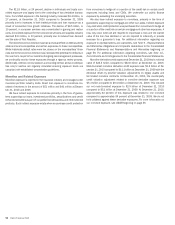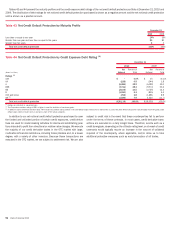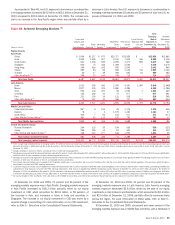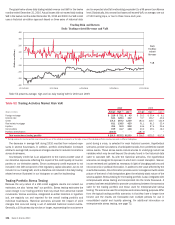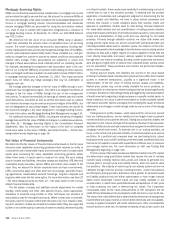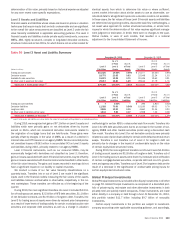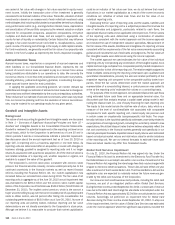Bank of America 2010 Annual Report Download - page 106
Download and view the complete annual report
Please find page 106 of the 2010 Bank of America annual report below. You can navigate through the pages in the report by either clicking on the pages listed below, or by using the keyword search tool below to find specific information within the annual report.Market Risk Management
Market risk is the risk that values of assets and liabilities or revenues will be
adversely affected by changes in market conditions such as market move-
ments. This risk is inherent in the financial instruments associated with our
operations and/or activities including loans, deposits, securities, short-term
borrowings, long-term debt, trading account assets and liabilities, and deriv-
atives. Market-sensitive assets and liabilities are generated through loans
and deposits associated with our traditional banking business, customer and
other trading operations, the ALM process, credit risk mitigation activities and
mortgage banking activities. In the event of market volatility, factors such as
underlying market movements and liquidity have an impact on the results of
the Corporation.
Our traditional banking loan and deposit products are nontrading positions
and are generally reported at amortized cost for assets or the amount owed
for liabilities (historical cost). However, these positions are still subject to
changes in economic value based on varying market conditions, primarily
changes in the levels of interest rates. The risk of adverse changes in the
economic value of our nontrading positions is managed through our ALM
activities. We have elected to account for certain assets and liabilities under
the fair value option. For further information on the fair value of certain
financial assets and liabilities, see Note 22 – Fair Value Measurements to the
Consolidated Financial Statements.
Our trading positions are reported at fair value with changes currently
reflected in income. Trading positions are subject to various risk factors, which
include exposures to interest rates and foreign exchange rates, as well as
mortgage, equity, commodity, issuer and market liquidity risk factors. We seek
to mitigate these risk exposures by using techniques that encompass a
variety of financial instruments in both the cash and derivatives markets.
The following discusses the key risk components along with respective risk
mitigation techniques.
Interest Rate Risk
Interest rate risk represents exposures to instruments whose values vary with
the level or volatility of interest rates. These instruments include, but are not
limited to, loans, debt securities, certain trading-related assets and liabilities,
deposits, borrowings and derivative instruments. Hedging instruments used
to mitigate these risks include derivatives such as options, futures, forwards
and swaps.
Foreign Exchange Risk
Foreign exchange risk represents exposures to changes in the values of
current holdings and future cash flows denominated in other currencies. The
types of instruments exposed to this risk include investments in non-U.S. sub-
sidiaries, foreign currency-denominated loans and securities, future cash
flows in foreign currencies arising from foreign exchange transactions, foreign
currency-denominated debt and various foreign exchange derivative instru-
ments whose values fluctuate with changes in the level or volatility of currency
exchange rates or non-U.S. interest rates. Hedging instruments used to
mitigate this risk include foreign exchange options, currency swaps, futures,
forwards, foreign currency-denominated debt and deposits.
Mortgage Risk
Mortgage risk represents exposures to changes in the value of mortgage-
related instruments. The values of these instruments are sensitive to pre-
payment rates, mortgage rates, agency debt ratings, default, market liquidity,
other interest rates, government participation and interest rate volatility. Our
exposure to these instruments takes several forms. First, we trade and
engage in market-making activities in a variety of mortgage securities includ-
ing whole loans, pass-through certificates, commercial mortgages, and col-
lateralized mortgage obligations (CMOs) including CDOs using mortgages as
underlying collateral. Second, we originate a variety of MBS which involves the
accumulation of mortgage-related loans in anticipation of eventual securiti-
zation. Third, we may hold positions in mortgage securities and residential
mortgage loans as part of the ALM portfolio. Fourth, we create MSRs as part
of our mortgage origination activities. See Note 1 – Summary of Significant
Accounting Principles and Note 25 – Mortgage Servicing Rights to the Con-
solidated Financial Statements for additional information on MSRs. Hedging
instruments used to mitigate this risk include foreign exchange options,
currency swaps, futures, forwards and foreign currency-denominated debt.
Equity Market Risk
Equity market risk represents exposures to securities that represent an
ownership interest in a corporation in the form of domestic and foreign
common stock or other equity-linked instruments. Instruments that would
lead to this exposure include, but are not limited to, the following: common
stock, exchange-traded funds, American Depositary Receipts, convertible
bonds, listed equity options (puts and calls), over-the-counter equity options,
equity total return swaps, equity index futures and other equity derivative
products. Hedging instruments used to mitigate this risk include options,
futures, swaps, convertible bonds and cash positions.
Commodity Risk
Commodity risk represents exposures to instruments traded in the petroleum,
natural gas, power and metals markets. These instruments consist primarily
of futures, forwards, swaps and options. Hedging instruments used to mit-
igate this risk include options, futures and swaps in the same or similar
commodity product, as well as cash positions.
Issuer Credit Risk
Issuer credit risk represents exposures to changes in the creditworthiness of
individual issuers or groups of issuers. Our portfolio is exposed to issuer
credit risk where the value of an asset may be adversely impacted by changes
in the levels of credit spreads, by credit migration or by defaults. Hedging
instruments used to mitigate this risk include bonds, credit default swaps and
other credit fixed-income instruments.
Market Liquidity Risk
Market liquidity risk represents the risk that the level of expected market
activity changes dramatically and, in certain cases, may even cease to exist.
This exposes us to the risk that we will not be able to transact business and
execute trades in an orderly manner which may impact our results. This
impact could further be exacerbated if expected hedging or pricing correla-
tions are compromised by the disproportionate demand or lack of demand for
certain instruments. We utilize various risk mitigating techniques as dis-
cussed in more detail below.
Trading Risk Management
Trading-related revenues represent the amount earned from trading positions,
including market-based net interest income, in a diverse range of financial
instruments and markets. Trading account assets and liabilities and deriva-
tive positions are reported at fair value. For more information on fair value,
see Note 22 – Fair Value Measurements to the Consolidated Financial State-
ments. Trading-related revenues can be volatile and are largely driven by
general market conditions and customer demand. Trading-related revenues
are dependent on the volume and type of transactions, the level of risk
assumed, and the volatility of price and rate movements at any given time
within the ever-changing market environment.
The Global Markets Risk Committee (GRC), chaired by the Global Markets
Risk Executive, has been designated by ALMRC as the primary governance
104 Bank of America 2010


